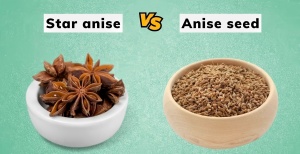Star anise vs anise extract

Star anise and anise extract are often confused due to their similar names and flavors, but they come from entirely different plants and have distinct characteristics. Understanding their origins, flavor profiles, culinary uses, and health benefits helps consumers and professionals make the right choice in the kitchen or for medicinal purposes.
Botanical Origins and Composition
Though both contain anethole, the compound responsible for their sweet, licorice-like taste, star anise and anise extract are botanically unrelated.
Star Anise
Star anise comes from the star-shaped fruit of *Illicium verum*, a tree native to China and Vietnam. It is a dried spice widely used in Asian cooking and traditional medicine. Its essential oil is also extracted and used in pharmaceuticals and perfumery.
Anise Extract
Anise extract is typically derived from the seeds of the *Pimpinella anisum* plant, which belongs to the parsley family. It is more commonly used in Western cuisine, especially in baking and confections. The extract is usually alcohol-based and highly concentrated in flavor.
Flavor and Aroma Comparison
While both are sweet and licorice-like, their flavors are not identical, which matters in culinary applications.
Star Anise Flavor Profile
Star anise has a bolder, more intense flavor with a slightly bitter edge and earthy undertones. It performs well in slow-cooked dishes like soups, broths, and marinades, especially in savory Asian recipes such as pho or Chinese five-spice powder.
Anise Extract Flavor Profile
Anise extract offers a sweeter, more delicate taste. It is ideal for baking cookies, flavoring liquors like ouzo or absinthe, and enhancing desserts. It lacks the depth of star anise but brings a refined aromatic touch to sweets and beverages.
Culinary Applications
Choosing between star anise and anise extract depends heavily on the cooking method and cultural context of the recipe.
Star Anise in Cooking
Star anise is used whole or ground in savory dishes. It’s best suited for stews, curries, and braised meats. It pairs well with cloves, cinnamon, and fennel. Whole star anise is often simmered and then removed before serving, much like bay leaves.
Anise Extract in Recipes
Anise extract is measured in small amounts due to its concentration. A few drops can transform a dough, cream, or beverage. It’s popular in holiday cookies, breads, and liqueurs. Unlike star anise, it is rarely used in savory cooking.
Health Benefits and Uses
Both have long-standing traditional uses in herbal medicine but differ in active compounds beyond anethole.
Star Anise Benefits
Star anise contains shikimic acid, a precursor to the antiviral drug oseltamivir (Tamiflu). It also has antibacterial and antifungal properties. In traditional medicine, it is used to ease digestive issues, boost immunity, and relieve cold symptoms.
Anise Extract Benefits
Anise extract is used to alleviate bloating, stimulate appetite, and ease coughs. Its carminative effect makes it useful in herbal teas. While not as medicinally potent as star anise, it is still a valued component of natural remedies for mild digestive discomforts.
Safety and Considerations
Understanding the differences also includes knowing their safety profiles and proper usage limits.
Star Anise Risks
There are two types of star anise: Chinese (safe) and Japanese (toxic). Only Chinese star anise is edible. The Japanese variety contains neurotoxins and must be avoided. Always source from reputable suppliers.
Anise Extract Allergies
Some individuals may be allergic to anise or its compounds. Anise extract may also interact with estrogen-sensitive conditions due to its phytoestrogen content, so consultation with a healthcare provider is recommended for those with related medical histories.


